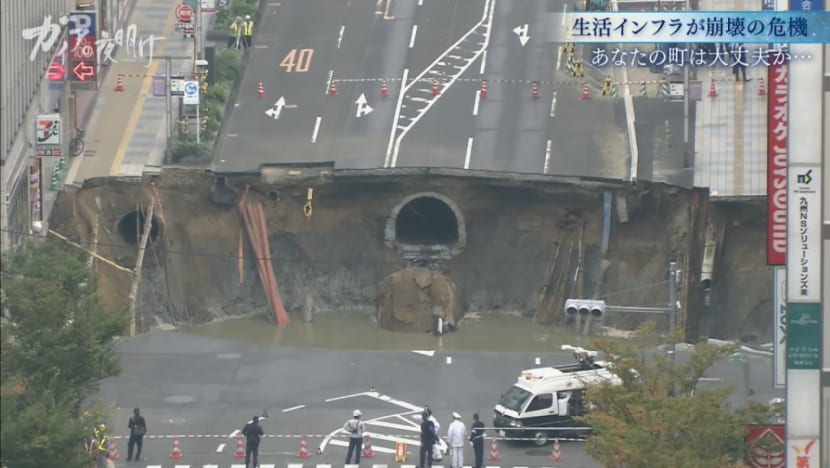Entertainment
Japan Innovates to Address Hidden Infrastructure Crisis

Japan is grappling with a significant infrastructure crisis, marked by deteriorating sewer systems and aging bridges. The situation has escalated to alarming levels, prompting innovative solutions from engineers and builders. This week’s episode of the Gaia Series delves into the challenges and breakthroughs occurring across the country as Japan confronts its hidden infrastructure vulnerabilities.
The turning point came in January 2024 when a damaged sewer pipe in Yashio City, Saitama Prefecture, caused a catastrophic road collapse. A lorry fell into the sinkhole, tragically claiming the driver’s life. Around 200 households were evacuated, and approximately 1.2 million residents were warned against using local drains. Local taxi driver Kenji Sato described the shock of the incident: “I had no idea the sewer pipe was 10 metres below.” This incident underscored the urgent need for infrastructure repairs, as the Ministry of Land, Infrastructure, Transport and Tourism estimates that 40,000 kilometres of sewer pipes in Japan have exceeded their 50-year lifespan.
Road collapses due to sewer damage now occur approximately 2,600 times each year. By 2043, more than 40 percent of sewer pipes will have surpassed their intended life, a dramatic increase from 7.4 percent in 2023. Inspection teams struggle to keep up with the growing problem, hindered by limited budgets and a shortage of skilled workers.
In response to these challenges, engineers like Kosuke Nohira from the drone company Liberaware are employing cutting-edge technology. Nohira’s team utilizes IBIS, a compact inspection drone adept at navigating “dark, narrow and dirty spaces.” Designed to withstand collisions, IBIS can also convert camera footage into 3D data to identify cracks and other issues. The drone was deployed in Yashio’s foul water pipes, where toxic gases prevented human access. It notably captured footage of the area where the lorry had fallen.
Yet, the technology faced limitations. Underground pipes obstruct GPS signals, leaving the team without precise location tracking. “From our side, as the creators, we came back thinking we had done something amazing,” Nohira said. “But not knowing the exact location left us with deep frustration.” This setback delayed rescue efforts, prompting Nohira and his team to develop a miniature distance measuring device. By May, they had created a prototype weighing just 30 grams, capable of pinpointing IBIS’s location underground to within three metres.
Chiba City officials praised the innovation, with Masayoshi Ono from the sewage maintenance division noting, “The cost and time required are completely different.” This technology has not only been instrumental in sewer inspections but has also aided in post-earthquake rescues, capturing critical footage beneath the reactor containment vessel at the Fukushima Daiichi nuclear plant.
The focus then shifts above ground, where Japan’s bridges are in need of urgent repairs. Over 56,000 bridges nationwide require attention, yet more than half of these have not begun repairs. In Ube City, Yamaguchi Prefecture, Takashi Yamamoto, president of MBS, is revolutionizing bridge maintenance with his “Skeleton Method.” This approach involves using transparent glass fibre sheets to cover repaired areas, allowing engineers to see cracks as they reappear.
While initially met with skepticism, the method has proven to be both faster and more cost-effective, reducing repair times by two-thirds and costs by 30 to 40 percent. The technique has been successfully implemented on the Second Keihan Road bridge for 15 years without incidents of concrete falling off. Following the tragic 2012 Sasago Tunnel ceiling collapse that resulted in nine fatalities, there has been a surge in demand for safer repair methods.
Yamamoto’s innovations extend further, including the integration of QR codes beneath the protective coating, preserving repair histories for future reference. “Even if decades pass, the repair information can still be passed on,” he explained. His ultimate goal is clear: “I want to fix it all.”
Looking ahead, plans are underway to move Tokyo’s Nihonbashi expressway underground by 2040, restoring blue skies to this historic landmark. The hope is that these transformative initiatives will not only improve infrastructure but also restore public confidence in the safety of Japan’s vital systems. As the nation confronts its infrastructure crisis, the blend of technology and innovative thinking demonstrates a commitment to safeguarding lives and enhancing safety for future generations.
-

 Business5 months ago
Business5 months agoKenvue Dismisses CEO Thibaut Mongon as Strategic Review Advances
-

 Lifestyle4 months ago
Lifestyle4 months agoHumanism Camp Engages 250 Youths in Summer Fest 2025
-

 Sports4 months ago
Sports4 months agoDe Minaur Triumphs at Washington Open After Thrilling Comeback
-

 Sports5 months ago
Sports5 months agoTupou and Daugunu Join First Nations Squad for Lions Clash
-

 Top Stories5 months ago
Top Stories5 months agoColombian Senator Miguel Uribe Shows Signs of Recovery After Attack
-

 World5 months ago
World5 months agoASEAN Gears Up for Historic Joint Meeting of Foreign and Economic Ministers
-

 Health4 months ago
Health4 months agoNew Study Challenges Assumptions About Aging and Inflammation
-

 Business5 months ago
Business5 months agoOil Prices Surge Following New EU Sanctions on Russia
-

 Entertainment4 months ago
Entertainment4 months agoDetaşe-Sabah Violin Ensemble Captivates at Gabala Music Festival
-

 Entertainment4 months ago
Entertainment4 months agoBaku Metro Extends Hours for Justin Timberlake Concert
-

 Top Stories5 months ago
Top Stories5 months agoRethinking Singapore’s F&B Regulations Amid Business Closures
-

 Business5 months ago
Business5 months agoU.S. House Approves Stablecoin Bill, Sends to Trump for Signature









